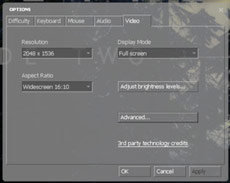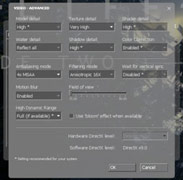HIS Radeon HD 4850 IceQ 4 TurboX 512MB
Written by Tim Smalley
October 3, 2008 | 07:38
Tags: #4850 #article #card #consumption #evaluation #fan #hd #iceq #iceq4 #noise #overclocking #performance #power #radeon #review #rv770 #speed #turbox

Half Life 2: Episode 2
Publisher: ValveAs one part of our game of the year 2007, Half-Life 2: Episode Two set a new high in narrative and gameplay for the series. Using Valve's widely used, albeit not overly hardware intensive, Source engine that also features as a part of legendary games like Counter-Strike, Team Fortress 2 and Portal, we were keen to feature its performance here too.
The Source engine is the most scalable engine we test. While it still supports only DirectX 9.0, it features effects like dynamic lighting with HDR effects, motion blur, advanced Havok Physics and high model details.
Episode Two took Half-Life outside into large open environments for the first time and we test with Gordon running through a large open level that combines forest and houses, with explosions and physics.
All in game detail settings are set to their highest levels, with HDR enabled, and for anti-aliasing MSAA was used where both settings were set from inside the game.
Half-Life 2: Episode Two
1680x1050 4xAA, 16xAF, DX9, Maximum Detail
- ATI Radeon HD 4870 X2
- Nvidia GeForce GTX 280
- BFG Tech GeForce GTX 260 OCX Maxcore
- Zotac GeForce GTX 260 AMP!
- ATI Radeon HD 4870
- Nvidia GeForce GTX 260
- ATI Radeon HD 3870 X2
- HIS Radeon HD 4850 IceQ 4 TurboX
- Powercolor Radeon HD 4850 PCS+
- ATI Radeon HD 4850
- Nvidia GeForce 9800 GTX+
- Nvidia GeForce 8800 GT
-
-
157.0
-
-
-
147.0
-
-
-
140.0
-
-
-
134.0
-
-
-
131.0
-
-
-
131.0
-
-
-
115.0
-
-
-
115.0
-
-
-
112.0
-
-
-
107.0
-
-
-
105.0
-
-
-
86.0
-
0
25
50
75
100
125
150
175
Frames Per Second
-
Average
Half-Life 2: Episode Two
1680x1050 8xAA, 16xAF, DX9, Maximum Detail
- ATI Radeon HD 4870 X2
- Nvidia GeForce GTX 280
- BFG Tech GeForce GTX 260 OCX Maxcore
- ATI Radeon HD 4870
- Zotac GeForce GTX 260 AMP!
- Nvidia GeForce GTX 260
- ATI Radeon HD 3870 X2
- HIS Radeon HD 4850 IceQ 4 TurboX
- Powercolor Radeon HD 4850 PCS+
- ATI Radeon HD 4850
- Nvidia GeForce 9800 GTX+
- Nvidia GeForce 8800 GT
-
-
156.0
-
-
-
129.0
-
-
-
121.0
-
-
-
120.0
-
-
-
111.0
-
-
-
106.0
-
-
-
106.0
-
-
-
105.0
-
-
-
101.0
-
-
-
97.0
-
-
-
80.0
-
-
-
63.0
-
0
25
50
75
100
125
150
175
Frames Per Second
-
Average
Half-Life 2: Episode Two
1920x1200 4xAA, 16xAF, DX9, Maximum Detail
- ATI Radeon HD 4870 X2
- Nvidia GeForce GTX 280
- BFG Tech GeForce GTX 260 OCX Maxcore
- Zotac GeForce GTX 260 AMP!
- Nvidia GeForce GTX 260
- ATI Radeon HD 4870
- HIS Radeon HD 4850 IceQ 4 TurboX
- ATI Radeon HD 3870 X2
- Powercolor Radeon HD 4850 PCS+
- ATI Radeon HD 4850
- Nvidia GeForce 9800 GTX+
- Nvidia GeForce 8800 GT
-
-
148.0
-
-
-
137.0
-
-
-
130.0
-
-
-
120.0
-
-
-
115.0
-
-
-
115.0
-
-
-
99.5
-
-
-
99.0
-
-
-
96.0
-
-
-
92.0
-
-
-
90.0
-
-
-
72.0
-
0
25
50
75
100
125
150
Frames Per Second
-
Average
Half-Life 2: Episode Two
1920x1200 8xAA, 16xAF, DX9, Maximum Detail
- ATI Radeon HD 4870 X2
- Nvidia GeForce GTX 280
- BFG Tech GeForce GTX 260 OCX Maxcore
- ATI Radeon HD 4870
- Zotac GeForce GTX 260 AMP!
- Nvidia GeForce GTX 260
- ATI Radeon HD 3870 X2
- HIS Radeon HD 4850 IceQ 4 TurboX
- Powercolor Radeon HD 4850 PCS+
- ATI Radeon HD 4850
- Nvidia GeForce 9800 GTX+
- Nvidia GeForce 8800 GT
-
-
146.0
-
-
-
112.0
-
-
-
106.0
-
-
-
104.0
-
-
-
98.0
-
-
-
92.0
-
-
-
91.0
-
-
-
90.0
-
-
-
86.0
-
-
-
83.0
-
-
-
67.0
-
-
-
53.0
-
0
25
50
75
100
125
150
Frames Per Second
-
Average
Half-Life 2: Episode Two
2560x1600, 4xAA, 16xAF, DX9, Maximum Detail
- ATI Radeon HD 4870 X2
- Nvidia GeForce GTX 280
- BFG Tech GeForce GTX 260 OCX Maxcore
- Zotac GeForce GTX 260 AMP!
- Nvidia GeForce GTX 260
- ATI Radeon HD 4870
- ATI Radeon HD 3870 X2
- HIS Radeon HD 4850 IceQ 4 TurboX
- Powercolor Radeon HD 4850 PCS+
- Nvidia GeForce 9800 GTX+
- ATI Radeon HD 4850
- Nvidia GeForce 8800 GT
-
-
126.0
-
-
-
101.0
-
-
-
92.0
-
-
-
85.0
-
-
-
77.0
-
-
-
72.0
-
-
-
64.0
-
-
-
62.0
-
-
-
59.0
-
-
-
58.0
-
-
-
57.0
-
-
-
45.0
-
0
25
50
75
100
125
Frames Per Second
-
Average
Half-Life 2: Episode Two
2560x1600, 8xAA, 16xAF, DX9, Maximum Detail
- ATI Radeon HD 4870 X2
- Nvidia GeForce GTX 280
- BFG Tech GeForce GTX 260 OCX Maxcore
- Zotac GeForce GTX 260 AMP!
- ATI Radeon HD 4870
- Nvidia GeForce GTX 260
- HIS Radeon HD 4850 IceQ 4 TurboX
- ATI Radeon HD 3870 X2
- Powercolor Radeon HD 4850 PCS+
- ATI Radeon HD 4850
- Nvidia GeForce 9800 GTX+
- Nvidia GeForce 8800 GT
-
-
116.0
-
-
-
76.0
-
-
-
66.0
-
-
-
62.0
-
-
-
62.0
-
-
-
56.0
-
-
-
54.0
-
-
-
53.0
-
-
-
51.0
-
-
-
49.0
-
-
-
30.0
-
-
-
23.0
-
0
25
50
75
100
125
Frames Per Second
-
Average
The pre-overclocked HIS 4850 again holds up well to the challenge from Nvidia's GeForce 9800 GTX+ and outperforms it at every setting tested here. It's not quite fast enough to be a serious challenge to the GTX 260 in terms of raw performance, but when you take pricing into account, it starts to look pretty attractive for the HIS card.











Want to comment? Please log in.